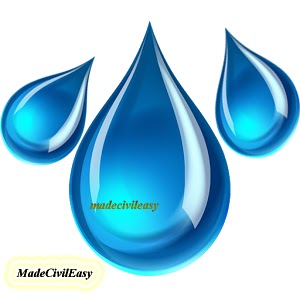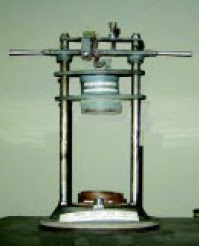TESTS ON AGGREGATES
1. SIEVE ANALYSIS
AIM:To determine the particle size distribution of fine and coarse aggregates by sieving as per IS: 2386 (Part I) - 1963.
PRINCIPLE
By passing the sample downward through a series of standard sieves, each of decreasing size openings, the aggregates are separated into several groups, each of which contains aggregates in a particular size range.
APPARATUS
A SET OF IS SIEVES
i) A set of IS Sieves of sizes - 80mm, 63mm, 50mm, 40mm,31.5mm, 25mm, 20mm, 16mm, 12.5mm, 10mm, 6.3mm, 4.75mm, 3.35mm, 2.36mm, 1.18mm, 600μm, 300μm, 150μm
and 75μm
ii) Balance or scale with an accuracy to measure 0.1 percent of the weight of the test sample
PROCEDURE
i) The test sample is dried to a constant weight at a temperature of 110 + 5oC and weighed.
ii) The sample is sieved by using a set of IS Sieves.
iii) On completion of sieving, the material on each sieve is weighed.
iv) Cumulative weight passing through each sieve is calculated as a percentage of the total sample weight.
v) Fineness modulus is obtained by adding cumulative percentage of aggregates retained on each sieve and dividing the sum by 100.
REPORTING OF RESULTS
The results should be calculated and reported as:
i) the cumulative percentage by weight of the total sample
ii) the percentage by weight of the total sample passing through one sieve and retained on the next smaller sieve, to the nearest 0.1 percent.
The results of the sieve analysis may be recorded graphically on a semi-log graph with particle size as abscissa (log scale) and the percentage smaller than the specified diameter as ordinate.
2. WATER ABSORPTION
AIM: To determine the water absorption of coarse aggregates as per IS: 2386 (Part III) - 1963.
APPARATUS
i) Wire basket - perforated, electroplated or plastic coated with wire hangers for suspending it from the balance.
ii) Water-tight container for suspending the basket
iii) Dry soft absorbent cloth - 75cm x 45cm (2 nos.)
iv) Shallow tray of minimum 650 sq.cm area
v) Air-tight container of a capacity similar to the basket
vi) Oven
SAMPLE
A sample not less than 2000g should be used.
PROCEDURE
i) The sample should be thoroughly washed to remove finer particles and dust, drained and then placed in the wire basket and immersed in distilled water at a temperaturebetween 22 and 32 degree C.
ii) After immersion, the entrapped air should be removed by lifting the basket and allowing it to drop 25 times in 25 seconds. The basket and sample should remain immersed for a period of 24 + - ½ hrs. afterwards.
iii) The basket and aggregates should then be removed from the
water, allowed to drain for a few minutes, after which the aggregates should be gently emptied from the basket on to one of the dry clothes and gently surface-dried with the cloth, transferring it to a second dry cloth when the first would remove no further moisture. The aggregates should be spread on the second cloth and exposed to the atmosphere away from direct sunlight till it appears to be completely surface-dry. The aggregates should be weighed (Weight 'A').
iv) The aggregates should then be placed in an oven at a temperature of 100 to 110oC for 24hrs. It should then be removed from the oven, cooled and weighed (Weight 'B').
REPORTING OF RESULTS
Water absorption =[(A - B)/B]x 100%
Two such tests should be done and the individual and mean results should be reported.
A sample proforma for the record of the test results is given in
3. AGGREGATE ABRASION VALUE
AIM: To determine the abrasion value of coarse aggregates as per IS: 2386 (Part IV) - 1963.
APPARATUS
i) Los Angles abrasion testing machine
ii) IS Sieve of size - 1.7mm
iii) Abrasive charge - 12 nos. cast iron or steel spheres approximately 48mm dia. and each weighing between 390 and 445g ensuring that the total weight of charge is 5000 + - 25g
iv) Oven
PREPARATION OF SAMPLE
The test sample should consist of clean aggregates which has been dried in an oven at 105 to 110oC to a substantially constant weight.
PROCEDURE
The test sample and the abrasive charge should be placed in the Los Angles abrasion testing machine and the machine rotated at a speed of 20 to 33 revolutions/minute for 1000 revolutions. At the completion of the test, the material should be discharged and sieved through 1.70mm IS Sieve.
REPORTING OF RESULTS
i) The material coarser than 1.70mm IS Sieve should be washed, dried in an oven at a temperature of 100 to 110oC to a constant weight and weighed (Weight 'B').
ii) The proportion of loss between weight 'A' and weight 'B' of the test sample should be expressed as a percentage of the original weight of the test sample. This value should be reported as,
Aggregate abrasion value = [(A-B)/A] x 100%
4. AGGREGATE IMPACT VALUE
AIM:To determine the aggregate impact value of coarse aggregates as per IS: 2386 (Part IV) - 1963.
APPARATUS
i) Impact testing machine conforming to IS: 2386 (Part IV)- 1963
ii) IS Sieves of sizes - 12.5mm, 10mm and 2.36mm
iii) A cylindrical metal measure of 75mm dia. and 50mm depth
iv) A tamping rod of 10mm circular cross section and 230mm length, rounded at one end
v) Oven
PREPARATION OF SAMPLE
i) The test sample should conform to the following grading:
- Passing through 12.5mm IS Sieve 100%
- Retention on 10mm IS Sieve 100%
ii) The sample should be oven-dried for 4hrs. at a temperature
of 100 to 110oC and cooled.
iii) The measure should be about one-third full with the prepared aggregates and tamped with 25 strokes of the tamping rod.
A further similar quantity of aggregates should be added and a further tamping of 25 strokes given. The measure should finally be filled to overflow, tamped 25 times and the surplus aggregates struck off, using a tamping rod as a straight edge. The net weight of the aggregates in the measure
should be determined to the nearest gram (Weight 'A').
PROCEDURE
i) The cup of the impact testing machine should be fixed firmly in position on the base of the machine and the whole of the test sample placed in it and compacted by 25 strokes of the
tamping rod.
ii) The hammer should be raised to 380mm above the upper surface of the aggregates in the cup and allowed to fall freely onto the aggregates. The test sample should be subjected to a total of 15 such blows, each being delivered at an interval of not less than one second.
REPORTING OF RESULTS
i) The sample should be removed and sieved through a 2.36mm IS Sieve. The fraction passing through should be weighed (Weight 'B'). The fraction retained on the sieve should also be weighed (Weight 'C') and if the total weight (B+C) is less than the initial weight (A) by more than one gram, the result should be discarded and a fresh test done.
ii) The ratio of the weight of the fines formed to the total sample weight should be expressed as a percentage.
Aggregate impact value = (B/A) x 100%
iii) Two such tests should be carried out and the mean of the results should be reported.
5. AGGREGATE CRUSHING VALUE
AIM:To determine the aggregate crushing value of coarse aggregates as per IS: 2386 (Part IV) - 1963.
APPARATUS:
i) Cylindrical measure and plunger
ii) Compression testing machine
iii) IS Sieves of sizes - 12.5mm, 10mm and 2.36mm
PROCEDURE
i) The aggregates passing through 12.5mm and retained on 10mm IS Sieve are oven-dried at a temperature of 100 to 110oC for 3 to 4hrs.
ii) The cylinder of the apparatus is filled in 3 layers, each layer tamped with 25 strokes of a tamping rod.
iii) The weight of aggregates is measured (Weight 'A').
iv) The surface of the aggregates is then levelled and the plunger inserted. The apparatus is then placed in the compression testing machine and loaded at a uniform rate so as to achieve 40t load in 10 minutes. After this, the load is released.
v) The sample is then sieved through a 2.36mm IS Sieve and the fraction passing through the sieve is weighed (Weight 'B').
vi) Two tests should be conducted.
REPORTING OF RESULTS
Aggregate crushing value = (B/A) x 100%
The result should be recorded to the first decimal place and the
mean of the two results reported.













